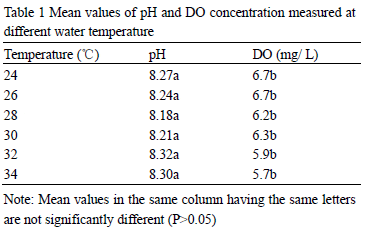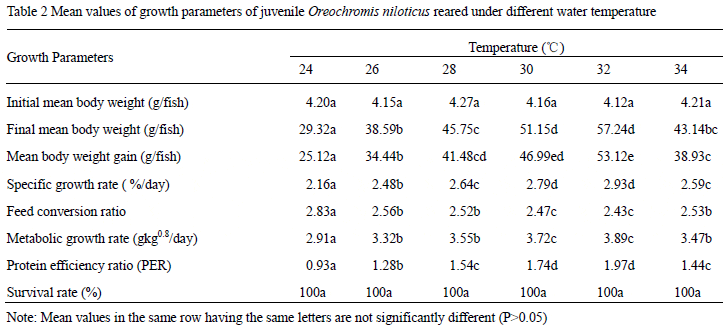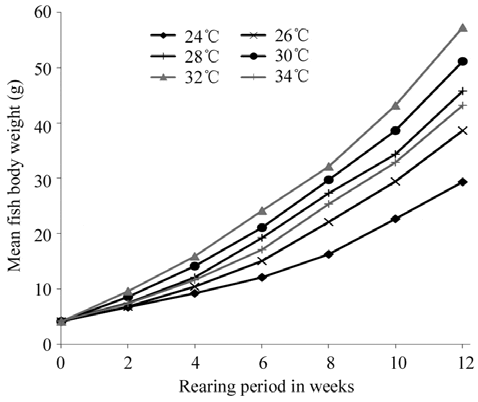Introduction
Nowadays, the demand of fish food is increasing throughout the world due to the recognition of its nutritional value (Tingman et al., 2010). In addition, the rise of food price and rapid human world population growth increase the demand of fish consumption (FAO, 2010; 2012). For these reasons, there are varieties of farming fish species get a special consideration to increase the world fish production. Tilapia is the second largest farmed fish group in the world next to carp (El-Sayed, 2006; FAO, 2012). The most commercially cultured fish species in the global tilapia farming is dominated by Oreochromis aureus (Bentsen et al., 1998; Pillay and Kutty, 2005; El-Sayed, 2006). The expansion of Oreochromis niloticus farming is due to its tolerance to a wide range of environmental conditions including factors such as pH, temperature, nitrogen wastes, low dissolved oxygen concentration and its easiness for handling practices (Noor et al., 2010). However, most tilapia does not eat and grow at lower water temperature. Thus, temperature is the natural limiting factors that influence the growth performance of tilapia (Pandit and Nakamura, 2010). "It is considered as driving force in the life of the fish as its effect is more than any other single factor" (Azevedo et al., 1998). Although, there are several researches that have been done worldwide, it is hard to get information about the optimum water temperature required for Oreochromis niloticus in Ethiopia. Therefore, the present study was planned to investigate the growth performance, feed utilization efficiency and survival rate of juvenile Oreochromis niloticus reared at different water temperature.
Results
The mean values of water quality parameters (pH and dissolved oxygen (DO) concentration) as well as the growth performance, feed utilization efficiency and survival rate data of the juvenile Oreochromis niloticus reared at different water temperature are summarized in Table 1 and Table 2. Similarly, the growth trends of all groups of fish are given in Figure 1. All groups of fish increased their growth performances steadily following exposure to their respective water temperature treatments. The physicochemical parameters such as pH and DO concentration were suitable environmental condition for rearing juvenile Oreochromis niloticus.



The highest growth performance of juvenile Oreochromis niloticus in terms of final mean body weight (FMBW), mean body weight gain (MBWG) and specific growth rate (SGR) was observed on the fish reared at 32°C water temperature followed by 30? as compared with other water temperature. Similarly, the best feed utilization efficiency of juvenile Oreochromis niloticus in terms of feed conversion ratio (FCR), metabolic growth rate (MGR) and protein efficiency ratio (PER) was observed on the fish reared at 32? water temperature followed by 30?. In all cases the lowest growth performance and the poorest feed utilization efficiency of juvenile Oreochromis niloticus were observed on the fish reared at 24? water temperature, and were significantly different (p<0.05). In general, the order of growth performance and feed utilization efficiency of juvenile Oreochromis niloticus is 32°C>30°C>28°C>34°C> 26°C>24°C (Figure 1).
Discussions
Physicochemical parameters of water
The growth performance and feed utilization efficiency of juvenile Oreochromis niloticus affected by different environmental factors such as pH, nitrogen waste, temperature, dissolved oxygen concentration and other water quality parameters (Gjedrem, 1997; Noor et al., 2010). The physicochemical parameters such as pH and dissolved oxygen concentration recorded during the experiment were not significantly different (p>0.05) and were suitable environmental conditions for rearing juvenile Oreochromis niloticus as mentioned by Saber et al (2004), Xu et al (2005) and Azaza et al (2008).
The mean values of pH ranged from 8.18 to 8.32 were optimum for rearing juvenile Oreochromis niloticus. These results were in agreement with the work of El-Sherif and El-Feky (2009a), who reported that the optimum pH values for optimum growth and feed utilization efficiency were between 7 and 8. The present results also showed that the range of dissolved oxygen concentration were from 5.7 to 6.7 mg/L which confirmed the earlier work of El-Sherif and El-Feky (2009b). These authors reported that fingerling of Oreochromis niloticus showed the best growth performance and feed utilization efficiency when dissolved oxygen concentration ranged from 6.5 to 6.7 mg/L. The work of Bahnasawy et al (2003) also confirmed the present results that the pH values ranged from 6.1 to 7.63 and dissolved oxygen concentration ranged from 6.1 to 8.4 mg/L were suitable for optimum growth performance and feed utilization efficiency of Oreochromis niloticus. In general, with the exception of water temperature, the water parameters for all aquaria were not significantly different (p>0.05). Moreover, the initial mean body size of juvenile Oreochromis niloticus was homogenous. Thus, variation in growth performance and feed utilization efficiency were caused due to differences in water temperatures.
Growth performance
Growth performance and feed utilization efficiency of juvenile Oreochromis niloticus reared at different water temperature treatments (24, 26, 28 30, 32 and 34°C) were significant (p<0.05). The highest final mean body weight of the fish was achieved at 32? water temperature followed by 30°C water temperature. Lower (24°C) and higher (34°C) water temperature caused reduction of final mean body weight of juvenile Oreochromis niloticus by 48.78 per cent and 24.63 per cent, respectively, which was attributed to a decrease in feed utilization efficiency and metabolic process (Larsson and Berglund, 2005).
Similarly, the highest mean body weight gain and specific growth rate were observed on the fish reared at 32°C followed by 30°C water temperature and were significantly different (p<0.05) from the fish reared at the rest of water temperatures. In this study, growth performance of juvenile Oreochromis niloticus in terms of the final mean body weight, mean body weight gain and specific growth rate increased gradually and reached to their maximum values at 32°C water temperature and decreased at 34°C water temperature. These results are in agreement to the earlier works of Saber et al (2004), El-sherif and El-Feky (2009a,b) and Pandit and Nakaura (2010), who reported that growth performance of juvenile Oreochromis niloticus reared at different water temperature increased as water temperature increased until 30°C to 32°C and declined when it excided. The present results were also confirmed the earlier works of Devline and Nagahama (2002) and Azaza et al (2008) who stated that lower and higher water temperature reduces the growth performance of juvenile Oreochromis niloticus. As mentioned by Azaza et al (2008), juvenile Oreochromis niloticus reared at 26°C and 30°C water temperature has higher body weight than reared at 22°C and 34°C water temperature. The results of the present study were also in line with the work of Pandit and Nakaura (2010), who reported that the growth performance of juvenile Oreochromis niloticus reduced at 35°C and 37°C water temperature as compared to 27°C and 32°C water temperature.
The best feed utilization efficiency (in terms of feed conversion ratio, metabolic growth rate and protein efficiency ratio) of juvenile Oreochromis niloticus was also recorded on the fish reared at 32°C followed by 30°C. The poorest feed utilization efficiency of juvenile Oreochromis niloticus was achieved by the fish reared at 24°C water temperature. These indicated that feed utilization efficiency increased with water temperature increased until 32°C and decreased as water temperature excide. These results were confirmed the earlier work of Pandit and Nakaura (2010) who reported the highest feed conversion ratio was achieved 32°C and decreased at 35°C and 37°C water temperature. Similar results were reported by El-Sherif and El-Feky (2009a,b). These authors noted that feed conversion ratio increased as water temperature increased from 20°C to 30°C.
The results also revealed that there was physiological disturbance in the fish reared at 34°C water temperature and had reddish colour around the fines and operculum which were not occur on the other fish reared at other rearing water temperature (Britz et al., 1997; Lei and Li, 2000). Moreover, higher water temperature initiates early sexual maturation as compared to lower water temperature. This implies that there is conflict between growth rate and early sexual maturation at higher water temperature. In general as mentioned by Usmani and Jafri (2002), protein utilisation efficiency is very low at lower (18°C) and higher 38°C water temperature and higher at optimum water temperature (28°C). This implies that optimum growth of fish can be achieved when their protein utilisation efficiency high at optimum water temperature.
Conclusions and Recommendation
The present results clearly demonstrated that the growth performance and feed utilization efficiency of juvenile Oreochromis niloticus reared in aquaria at different water temperature were significantly (p<0.05) different in which the fish reared at 32°C water temperature had the highest growth performance and feed utilization efficiency followed by 30°C. The poorest growth performance and feed utilization efficiency were observed at 24°C water temperature. It is worth to say that the optimum water temperature for best growth performance of juvenile Oreochromis niloticus is ranged from 28°C to 32°C.
This study also demonstrated the possibility of Oreochromis niloticus culture in the rift valley region of the country where the average temperature is above 26°C. The overall conclusion is that growth performance and feed utilization efficiency of juvenile Oreochromis niloticus are temperature dependent and thus, it is crucial to select the right water temperature for a specific fish species to a particular culturing area. However, there should be further investigation to achieve best Oreochromis niloticus production by delaying sexual maturation at higher water temperature to achieve maximum growth rate.
March 2014




